<< Previous | Displaying results 51-75 of 1587 for "poland" | Next >>
Killing centers (also referred to as "extermination camps" or "death camps") were designed to carry out genocide. Between 1941 and 1945, the Nazis established five killing centers in German-occupied Poland—Chelmno, Belzec, Sobibor, Treblinka, and Auschwitz-Birkenau (part of the Auschwitz camp complex). Chelmno and Auschwitz were established in areas annexed to Germany in 1939. The other camps (Belzec, Sobibor, and Treblinka) were established in the General Government (an administrative unit of occupied…



Fred was born to Polish Jewish parents in Berlin, where his father owned a factory. After the Kristallnacht ("Night of Broken Glass") pogrom in November 1938, Fred's father and brother were deported to Poland. It was not until June 1939, when Poland allowed Fred and his mother to enter the country, that the family was reunited in Krakow. Fred and his family tried to flee upon the German invasion of Poland in September 1939 but were told to return to their homes. They were forced into the Krakow ghetto, and…
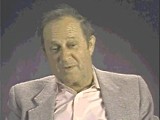
Susan was 19 years old when Germany invaded Poland in September 1939. Her boyfriend, Nathan, was in Lvov when the Soviet Union occupied eastern Poland. Nathan sent a guide to Warsaw to bring Susan to the Soviet zone of occupied Poland. Her parents reluctantly agreed after Susan promised to return to Warsaw within two weeks. Upon her arrival in Lvov, Susan married Nathan. The couple then fled across the Lithuanian border to Vilna, where they stayed for a year. They received a visa for transit through Japan…

Naftali Saleschutz (Norman Salsitz) prepares cement for the foundation of a sukkah (a hut-like structure used to celebrate the Jewish holiday of Sukkot). Kolbuszowa, Poland, 1937.
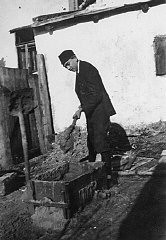

A transport of 200 Jewish children, fleeing postwar antisemitic violence in Poland, arrives at the Prague railroad station. The children are on their way to displaced persons camps in the American-occupied zone of Germany. Prague, Czechoslovakia, July 15, 1946.
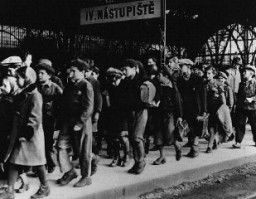




Two German sentries stand guard at Augustow on the demarcation line between Soviet- and German-occupied Poland. September 1939.
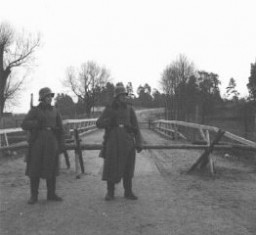
A post marked with Soviet symbols along the demarcation line between German- and Soviet-occupied Poland.
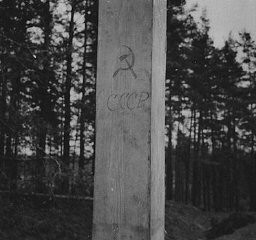
Aron and Lisa in Poland, ca. 1994, while accompanying high school students as part of a "Shoreshim" group.

Lucie Lind shopping in an open-air market in Lwów, Poland, sometime in the 1930s. Lucie was born into an affluent Jewish family on January 23, 1909. At the time, Lwów (Lemberg) was part of the Austro-Hungarian Empire. Lucie was educated in Vienna. Before World War II, she was a housewife. Her first husband was a well-known artist throughout Europe. The couple’s daughter was born in 1936. Lucie’s fashionable clothes, hat, and gloves are typical for middle or upper class women living in Poland at the…
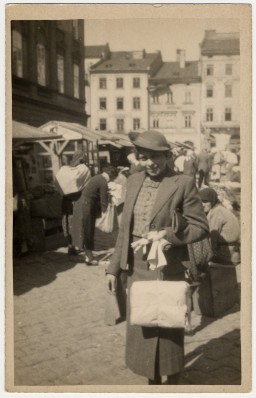
This portrait from around 1922 depicts three generations of the Menaker family. The hairstyles and clothing highlight the process of acculturation–adapting to and even adopting elements of the dominant, non-Jewish culture–in one Jewish family in the Lwów region. The older female relative wears a wig and a dress with long sleeves and a high collar. Orthodox Jewish women traditionally wore modest clothing and covered their hair with wigs or kerchiefs. By contrast, Szprinca (center) wears a dress with…
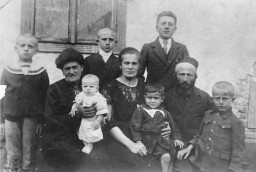
This 1935 portrait shows Samuel and Adela Shiber with three of their children—Salomon (left), Matylda (center), and Emanuel (right). The Shibers were a Jewish family from Lwów. Samuel owned a textile workshop in the city. Samuel and Adela spoke Yiddish at home, while the children spoke Polish among themselves. In this photo, there are no obvious markers of Jewish identity. The family wears clothing typical for middle or upper class families at the time. The children are dressed like most schoolchildren…
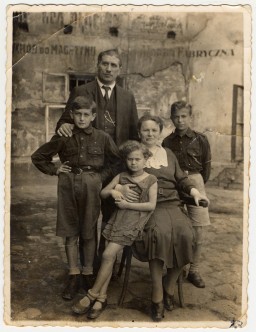
Wallace and his family were Polish Catholics. His father was a chemical engineer and his mother a teacher. The Germans occupied Kielce in 1939. Wallace witnessed pogroms against Jews in 1942. Wallace was active in the anti-Nazi resistance, acting as a courier between partisan groups. In 1946, in liberated Poland, Wallace witnessed the Kielce pogrom. He was reunited with his father in the United States in 1949; other family members followed. The Communist regime in Poland, however, denied his only sister…
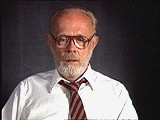
Frank was one of seven children born to a religious Jewish family in Kamionka, in the Lublin district of Poland. Germany invaded Poland in September 1939. When deportations of Jews from the Lublin area began in 1942, Frank joined a group of Jewish partisans who roamed the forests in search of weapons and food. After obtaining weapons by posing as Soviet paratroopers, they were able to defend themselves against German raids and take revenge against collaborators. They gradually made connections with Polish…
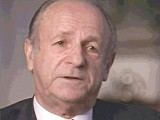
When the Soviet Union invaded eastern Poland in September 1939, Martin fled from the Soviet zone of occupied Poland to Vilna. He stayed there for about nine months and then moved to a small town about two hours from Vilna. The Soviets occupied Lithuania in 1940. Using forged identity documents, Martin obtained a visa for transit through Japan. He left Lithuania, traveling east along the Trans-Siberian Railroad to Vladivostok. There he boarded a ship for Japan. Martin remained in Japan until the fall of…
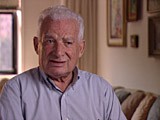
After World War I, Yonia's family moved to Vilna. Yonia studied painting and graduated from the Academy of Fine Arts in Vilna. When Germany invaded Poland in September 1939, Yonia was living with his wife in Warsaw. They fled to Brest-Litovsk in eastern Poland, occupied by Soviet forces in mid-September 1939. Then Yonia and his wife escaped to Vilna. After the Soviets occupied Vilna in June 1940, Yonia and his wife forged Japanese transit visas and left for Japan. In Japan, they were unable to obtain valid…
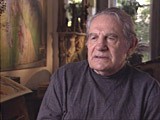
We would like to thank Crown Family Philanthropies, Abe and Ida Cooper Foundation, the Claims Conference, EVZ, and BMF for supporting the ongoing work to create content and resources for the Holocaust Encyclopedia. View the list of donor acknowledgement.